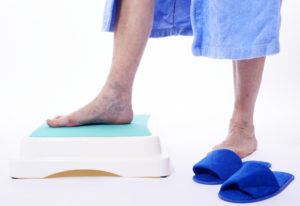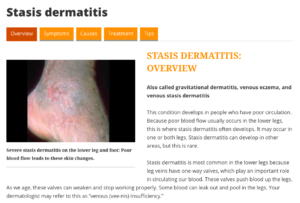About Stasis Dermatitis
About Stasis Dermatitis
Stasis dermatitis, aka venous eczema, is a common inflammatory skin disease sequela of chronic venous insufficiency that classically presents with diffuse erythematous and eczematous patches with scaling of the lower leg in patients suffering from compromised venous return (seen primarily in middle aged and elderly patients or iatrogenic following surgery). An estimated 6-7% of the population, or 15-20 million patients older than 50 years old, suffer from stasis dermatitis making it one of the most common dermatological manifestations.1 Patients often experience pruritus, reddish-brown skin discoloration with hyper-pigmentation of involved areas, and often dependent leg edema.2 Severe cases may involve the dorsum of the feet and may extend up to the knee.
Secondary complications of the condition include secondary cellulitis, increased incidence for developing allergic contact dermatitis, and non-healing venous ulcers, which is particularly prevalent over the medial malleolus. Venous leg ulceration and lipodermatosclerosis are two late stage complications of stasis dermatitis.
Pathophysiology:
Disruption of the one-way valve system of the venous plexus induces the backflow of venous blood away from the heart towards the feet, which causes venous hypertension and localized inflammatory reactions that result from a chronic “scratch and itch” cycle.3
Diagnostic criteria:
The diagnosis of stasis dermatitis is clinical. Accurate clinical diagnosis is essential considering that over 130,000 patients are unnecessarily hospitalized in the United States annually due to misdiagnosis for cellulitis.4 Doppler (ultrasound) studies can be utilized to access the venous circulation, which is particularly useful for acute onset in younger patients or patients with high thrombosis risks.
Treatment:
Stasis dermatitis treatments include compression therapy for the long-term management of edema and topical emollients to maintain and restore the skin barrier. Determination of ankle brachial index (ABI) should be made prior to treatment initiation. If ABI is >0.8, proceed with calf compression. Referral to vascular surgery if ABI is severely diminished (<0.5), or if symptomatic claudication occurs at rest. Corticosteroids may be used to temporarily to reduce inflammation during flares and wet to dry gauze dressing.2 More severe cases may require vessel ligation, laser, and grafting.5 Referral to dermatology if stasis dermatitis exacerbates, infection or ulcers develop.
***Disclaimer: Information above adapted from Medscape for educational purposes only. The information and education material herein is meant to promote a general understanding of stasis dermatitis care. Such information is not intended to substitute for a healthcare professional’s opinion or instructions and readers should always consult healthcare professionals regarding care.***
For more information please refer to:
Stasis Dermatitis Overview
National Eczema Association
An overview of stasis dermatitis presented by the National Eczema Association.
2 Minute Exercise with Dr. Robbins
Dr. Robbin’s 2 Minutes To Better Health – 3 Best Exercises For Increasing Blood Flow & Circulation To Your Legs
Stasis Dermatitis Overview
American Academy of Dermatology
An overview of stasis dermatitis presented by the American Academy of Dermatology.
1. Heit, J. A. et al. Trends in the incidence of venous stasis syndrome and venous ulcer: a 25-year population-based study. J Vasc Surg 33, 1022-1027, (2001).
2. Sundaresan, S., Migden, M. R. & Silapunt, S. Stasis Dermatitis: Pathophysiology, Evaluation, and Management. Am J Clin Dermatol 18, 383-390, (2017).
3. Paul, J. C., Pieper, B. & Templin, T. N. Itch: Association with Chronic Venous Disease, Pain and Quality of Life. J Wound Ostomy Continence Nurs 38, 46-54 (2011).
4. David, C. V. et al. Diagnostic accuracy in patients admitted to hospitals with cellulitis. Dermatol Online J 17, 1 (2011).
5. Dissemond, J., Knab, J., Lehnen, M., Franckson, T. & Goos, M. Successful treatment of stasis dermatitis with topical tacrolimus. Vasa 33, 260-262, (2004).
Click here to add your own text




